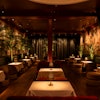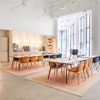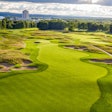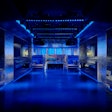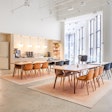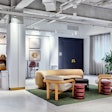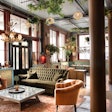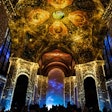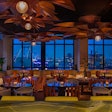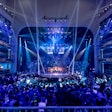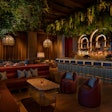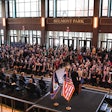Since he started his firm in 2003, designer David Monn has quickly won
high-profile jobs like the Met's Costume Institute gala. We asked him
how he dreams up dramatic decor.
Your firm is only about two and a half years old. How have you done so well so quickly?
It's strange, but really it's a funny thing and I've talked to my friends about this and they've been like, "You've been doing this your whole life, you've just never done it as a profession." And it really is the thing that I've done forever, whether it is doing it for my friends or fun or myself. I grew up in a very small town [Fayetteville, Pennsylvania] that was not wonderful. And I think as a child the thing I did most was daydream. And that was the way of getting out of where I was and to get to a place where I thought I could survive.
What I do today is kind of creating a fantasy that you can bring to life. I think reality is a place that can be very hard to be in. And fantasy can be tied to purposes in life. It's what all of us strive to do, to have something better in our lives. I really do have fun doing what I'm doing now, and it is a combination of why I have been successful very quickly. I don't like the word successful—I like to say I've been very fortunate to be able to have had great stages to perform on.You have gotten some high-profile events very quickly. How has that happened?
I've been in New York 23 years…I have been blessed with having some really, really good friends in New York and they happen to be friends who are influential or socially connected. Last year when I heard that the Met was looking, I called up a very good friend of mine who has been very much my sort of godmother in New York, Shirley Lord. She has known [Vogue editor and Costume Institute gala co-chairwoman] Anna [Wintour] since Anna was a young girl and worked in England for Anna's father. She called up and said, "You need to see my friend David." I never asked them this but I am sure on some level, this is the story. Anna had [Vogue special events director] Stephanie [Winston Wolkoff] call me and she was very polite. "Please send over your book." I sent her over my portfolio and it was, truly, a half hour. "Can you be in our office? Why don't we know you? Where have you been?" But it was that relationship that opened that door. I would have never gotten to the Met without having those kinds of relationships.
And I take a different approach to what we do, and because of my daydreaming and my fantasy and the talents that I have been given, we actually do every part of an event, which I have come to find out is very rare…I believe an event has to engage all five senses. And that's not a cliché phrase. It's really a fact. It's something I have always believed…That's what people who have come to the events that I've done have seen. My friends have opened the door but you have to be able to deliver on it.
When you're creating an event, what is your favorite detail to start with?
When I start out with an event what I try to go to first is: What is the purpose? How do you convey that clearly? I don't like anything contrived.
What is the test of whether or not it's contrived?
I think you have to ask yourself, "Does it make sense quickly or not?" I have a client who does special things at home and she wanted to do a little theme party. Last year we did Chinese New Year and it was really, really, really fun. She wanted to do something again this year. We started bouncing off themes of something and it just occurred to me if it doesn't have a root to how you live or what you're about, then you're sort of in the Emperor's new clothes and that never works. There's something trite in it. So we came up with a theme that has a root to her family.
What's your favorite way to heighten the drama?
Scale. It's always about scale. For me, I can never get scale big enough, because it has to be bigger than life to transport you. What I like to do is defy your sense of reality.
That's one of the things we do better than anybody is that I really have a sense of scale and proportions. And you know Robert [Isabell] was one of the first people who did anything with scale. You have to get really, really big. And then you have to be creative, or how can you afford to do it? It becomes very expensive to create scale.
The Fendi [anniversary and Halloween] event that we did, there were some elements in the space that we had to work with. There were these steel beams that couldn't be taken out. It worked out beautifully because I used them and put a truss on top of them and then we took cypress and junipers and just kept layering and layering and layering them until we built these 40-foot cypress tress. You couldn't imagine they weren't real.
That's when I think it really works. It all has to be at that right moment. Most times it's too small or it's so big that it overpowers you and you don't why it's there. When it's really right is when it just looks natural and you don't even really understand what it is.
Where do your ideas start—from a mood, from an object?
Different things, different times. It always starts off with "What's this for?" And then from that will start the ball rolling. And then I look at "What have I never seen done before?"
I've always believed putting a lot of things in my head and then I get down to editing them down. Bill Blass used to always say only a true artist can edit his own work, and in doing that do you really get to the space of what is pure. And that's what I try to do all the time. Getting to that purity.
I always try to get down to no more than two elements. It's in that distilled item that then is blown to scale is when it works.
I've always believed that when you take flowers and their beauty and you clump lots and lots of varieties together, they lose their beauty and they become something else. They're very pleasing to the eyes, but it's not memorable.
—Chad Kaydo
Photos: Chloe Crespi (Guggenheim), Courtest of David E. Monn (Fendi), Buff Strickland (Monn)
Your firm is only about two and a half years old. How have you done so well so quickly?
It's strange, but really it's a funny thing and I've talked to my friends about this and they've been like, "You've been doing this your whole life, you've just never done it as a profession." And it really is the thing that I've done forever, whether it is doing it for my friends or fun or myself. I grew up in a very small town [Fayetteville, Pennsylvania] that was not wonderful. And I think as a child the thing I did most was daydream. And that was the way of getting out of where I was and to get to a place where I thought I could survive.
What I do today is kind of creating a fantasy that you can bring to life. I think reality is a place that can be very hard to be in. And fantasy can be tied to purposes in life. It's what all of us strive to do, to have something better in our lives. I really do have fun doing what I'm doing now, and it is a combination of why I have been successful very quickly. I don't like the word successful—I like to say I've been very fortunate to be able to have had great stages to perform on.You have gotten some high-profile events very quickly. How has that happened?
I've been in New York 23 years…I have been blessed with having some really, really good friends in New York and they happen to be friends who are influential or socially connected. Last year when I heard that the Met was looking, I called up a very good friend of mine who has been very much my sort of godmother in New York, Shirley Lord. She has known [Vogue editor and Costume Institute gala co-chairwoman] Anna [Wintour] since Anna was a young girl and worked in England for Anna's father. She called up and said, "You need to see my friend David." I never asked them this but I am sure on some level, this is the story. Anna had [Vogue special events director] Stephanie [Winston Wolkoff] call me and she was very polite. "Please send over your book." I sent her over my portfolio and it was, truly, a half hour. "Can you be in our office? Why don't we know you? Where have you been?" But it was that relationship that opened that door. I would have never gotten to the Met without having those kinds of relationships.
And I take a different approach to what we do, and because of my daydreaming and my fantasy and the talents that I have been given, we actually do every part of an event, which I have come to find out is very rare…I believe an event has to engage all five senses. And that's not a cliché phrase. It's really a fact. It's something I have always believed…That's what people who have come to the events that I've done have seen. My friends have opened the door but you have to be able to deliver on it.
When you're creating an event, what is your favorite detail to start with?
When I start out with an event what I try to go to first is: What is the purpose? How do you convey that clearly? I don't like anything contrived.
What is the test of whether or not it's contrived?
I think you have to ask yourself, "Does it make sense quickly or not?" I have a client who does special things at home and she wanted to do a little theme party. Last year we did Chinese New Year and it was really, really, really fun. She wanted to do something again this year. We started bouncing off themes of something and it just occurred to me if it doesn't have a root to how you live or what you're about, then you're sort of in the Emperor's new clothes and that never works. There's something trite in it. So we came up with a theme that has a root to her family.
What's your favorite way to heighten the drama?
Scale. It's always about scale. For me, I can never get scale big enough, because it has to be bigger than life to transport you. What I like to do is defy your sense of reality.
That's one of the things we do better than anybody is that I really have a sense of scale and proportions. And you know Robert [Isabell] was one of the first people who did anything with scale. You have to get really, really big. And then you have to be creative, or how can you afford to do it? It becomes very expensive to create scale.
The Fendi [anniversary and Halloween] event that we did, there were some elements in the space that we had to work with. There were these steel beams that couldn't be taken out. It worked out beautifully because I used them and put a truss on top of them and then we took cypress and junipers and just kept layering and layering and layering them until we built these 40-foot cypress tress. You couldn't imagine they weren't real.
That's when I think it really works. It all has to be at that right moment. Most times it's too small or it's so big that it overpowers you and you don't why it's there. When it's really right is when it just looks natural and you don't even really understand what it is.
Where do your ideas start—from a mood, from an object?
Different things, different times. It always starts off with "What's this for?" And then from that will start the ball rolling. And then I look at "What have I never seen done before?"
I've always believed putting a lot of things in my head and then I get down to editing them down. Bill Blass used to always say only a true artist can edit his own work, and in doing that do you really get to the space of what is pure. And that's what I try to do all the time. Getting to that purity.
I always try to get down to no more than two elements. It's in that distilled item that then is blown to scale is when it works.
I've always believed that when you take flowers and their beauty and you clump lots and lots of varieties together, they lose their beauty and they become something else. They're very pleasing to the eyes, but it's not memorable.
—Chad Kaydo
Photos: Chloe Crespi (Guggenheim), Courtest of David E. Monn (Fendi), Buff Strickland (Monn)
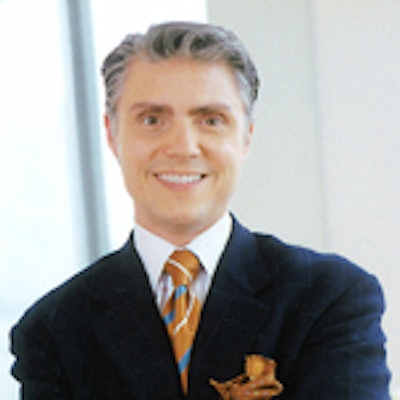
Photo: Buff Strickland

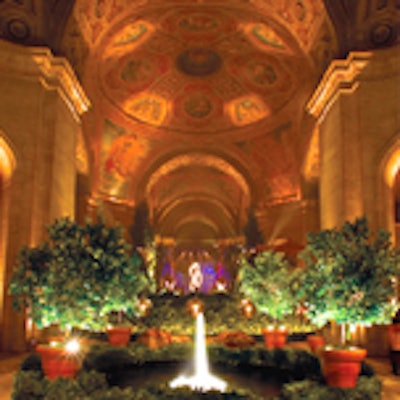
For a Halloween party celebrating Fendi's 80th anniversary, Monn recreated a Roman palazzo inside the Cunard Shipping building, a landmarked building with lofty 85-foot-high frescoed ceilings as well as marble columns and archways. He scattered potted lemon, lime, and orange trees, as well as 40-foot Italian cypress trees.

Monn created a chic look for the Guggenheim Museum's International gala, using a brown and white palette inside a white tent on the plaza of the Seagram Building. He covered long rectangular tables and banquet rounds with custom-made table linens of white silk taffeta sewn with wide strips of brown. Chocolate brown southern oak hedges surrounded the tent's walls and columns.


